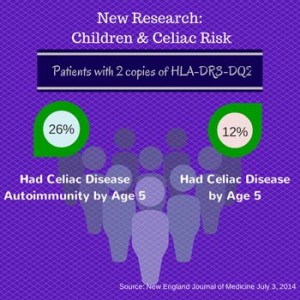Shedding light on which children may have a greater chance of celiac
July 9, 2014 by Amy Leger | G+ Amy Leger Revealing new research into why some children get celiac disease and others don’t sheds new light on celiac, children, and when doctors should test for it.
Revealing new research into why some children get celiac disease and others don’t sheds new light on celiac, children, and when doctors should test for it.
Published last week in the New England Journal of Medicine (easier to read version published by the National Institutes of Health – NIH), researchers said children who have two copies of the HLA-DR3-DQ2 gene had the “highest likelihood of [celiac] disease development by age 5,” the article from the NIH said.
In fact, 26% of the children with the two gene copies developed Celiac Disease Autoimmunity by age 5. Another 12% had celiac disease by the time they were 5. These numbers were cut by more than half when they had one copy of the HLA-DR3-DQ2 gene.
Right now the NASPGHAN guidelines recommend celiac testing for at-risk children around the age of 3. One of the authors of this study, Edwin Liu, M.D. of a pediatric gastroenterologist at the CU School of Medicine and Children’s Hospital Colorado, explained to The Savvy Celiac doctors need to know, in some cases, age 3 can be late for a celiac diagnosis. “Celiac disease can occur much earlier than this, even if a child doesn’t have overt symptoms,” Liu said. “This may change our screening recommendations in the future.”
So should we all be taking our kids to the doctor to get their genes tested to know whether they have two copies of HLA-DR3-DQ2? “Gene testing isn’t generally recommended (for now) but can be considered if you want to basically rule out the possibility of celiac disease,” Dr. Liu explained.
“The genes that put you at risk for celiac are quite common — 40% of the population has one or the other (or a combination) of HLA-DQ2 or DQ8.” Dr. Liu says if a family member has the gene, you will likely have it too. Having the gene doesn’t guarantee you will get celiac disease. But if you don’t have either gene then you can stop routine testing for celiac because you won’t likely get it.
The NIH says the HLA-DQ2 and DQ8 genes are “involved in presenting gluten to immune cells”.
The research also found that rates of celiac disease autoimmunity in Sweden are nearly double that of the United States. It also had higher rates of CDA and celiac disease than Finland. Researchers are still unclear why this is the case.
The ongoing study is funded by the National Institutes for Health. It is called TEDDY (a.k.a. The Environmental Determinants of Diabetes in Youth consortium). The NIH article says “TEDDY is studying celiac disease and type 1 diabetes because both are autoimmune diseases with some of the same genetic risk factors”.
While reading this study, one thing I couldn’t get off my brain is What is Celiac Disease Autoimmunity? Click here to learn more about that.
Tags: autoimmune, celiac, diabetes, diagnosis, disease, free, gene, genetic, gluten, gluten-free, testing, type 1



July 12th, 2014 at 11:05 pm
This is a very interesting article. It lines up exactly with what Dr. Fasano presented last month at the CDF conference. I actually brought him pics of my kids genetic tests because I was so confused by them, as were my kids’ doctors. Sure hope they come up with more reliable, less invasive celiac testing in the next few years!